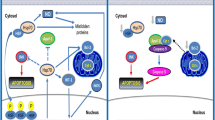Abstract
Background. A 47-kDa heat-shock protein (HSP47) is a major collagen-binding stress protein and is assumed to play an important role in the fibrotic process, but its role in cisplatin-induced tubulointerstitial fibrosis is not yet clear. To explore the possible role(s) of collagen-binding stress protein HSP47 in cisplatin-induced tubulointerstitial fibrosis, the expression of HSP47 was examined in cisplatin-treated rat kidneys.
Methods. Eighteen male Wistar rats were divided into two groups; group I were age-matched controls and group II, animals were injected intraperitoneally with a single dose of cisplatin (6 mg/kg body weight). One hour after cisplatin injection, three rats from group II were killed along with control rats. The remaining rats in both groups were killed on the 7th, 14th, and 28th days of the experiment and the kidneys were collected for morphological and immunohistochemical study. The expression of collagen-binding HSP47 with various proteins implicated in phenotypic modulation (α-smooth muscle actin and vimentin) and fibrosis (type I and type III collagens) was examined in control and cisplatin-treated kidneys.
Results. Cisplatin induced marked tubulointerstitial damage, including interstitial fibrosis, which was characterized by increased deposition of type I and type III collagens. Increased expression of HSP47 was also noted in and around the expanded interstitium in cisplatin-treated rats; by double-staining, HSP47-expressing cells were found to be α-smooth muscle actin-positive myofibroblasts and vimentin-positive tubular epithelial cells. In addition, colocalization of HSP47 and collagens was seen in and around the interstitial fibrosis in cisplatin-treated kidneys.
Conclusion. From the results, we concluded that overexpression of HSP47 by phenotypically altered renal cells may play an important role in the excessive assembly of collagens and could thereby contribute significantly to the development of the tubulointerstitial fibrosis found in cisplatin-treated rat kidneys.
Similar content being viewed by others
Author information
Authors and Affiliations
Additional information
Received: October 5, 1998 / Accepted: March 5, 1999
About this article
Cite this article
Razzaque, M., Taguchi, T. Localization of HSP47 in cisplatin-treated rat kidney: a possible role in tubulointerstitial damage. Clin Exp Nephrol 3, 222–228 (1999). https://doi.org/10.1007/s101570050039
Issue Date:
DOI: https://doi.org/10.1007/s101570050039




